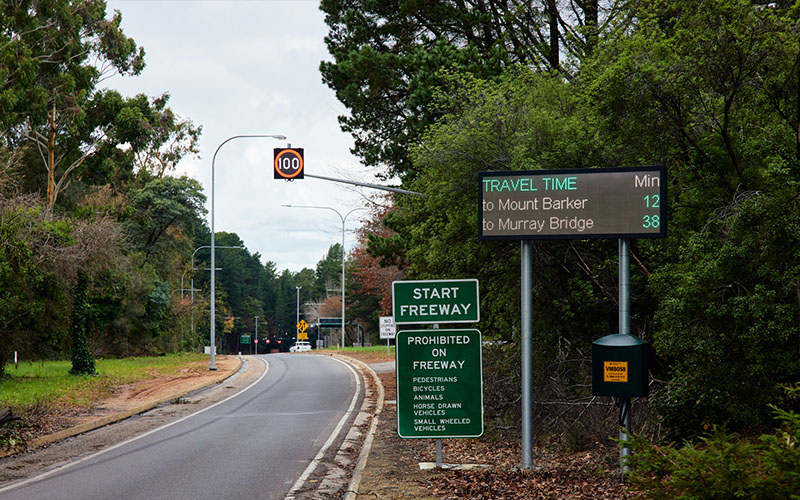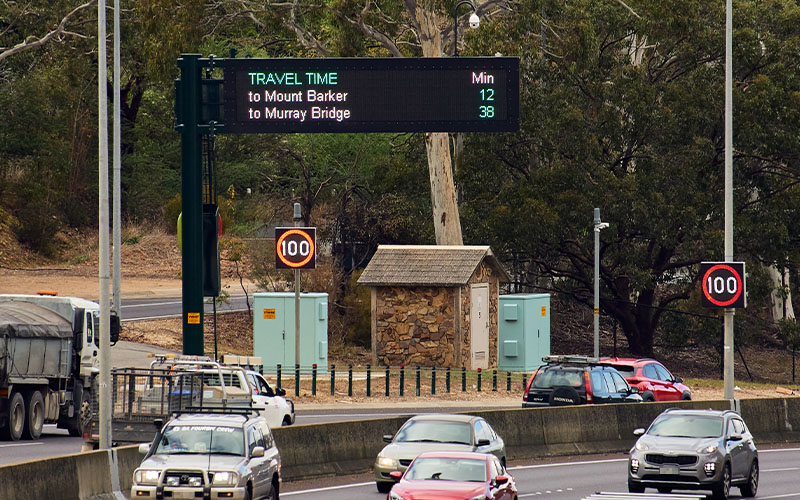The Stirling to Crafers Managed Motorway was designed, constructed, and commissioned in 9 months during a challenging COVID-19 situation at the time.
As a result of SAGE delivering the latest and best ITS solution, DIT now has a complete managed ITS solution between Crafers and Stirling to identify and manage congestion, enhance the safety of both commuters and workers, strengthen their traffic management capabilities to fully manage incidents, future-proof their operations, and access high-quality data to drive analytical decision-making.
Highlights
Safety in design
The Crafers to Stirling Managed Motorway is located in an area of the Adelaide Hills subject to extreme bushfire conditions. To reduce the exposure of maintenance personnel to bushfire scenarios, ITS cabinets have an Uninterruptible Power Supply (UPS) system. In the event of a mains power failure, the automatic bypass switch will automatically switch to bypass mode and power the cabinet from UPS batteries.
All devices are extra-low voltage except for the LUMS and VMS assets, reducing the risk to maintenance personnel in the event of a failure or collision with an asset.
Managed switches/power rails enable maintenance and network administrators to interrogate cameras and other ITS equipment, by remote power cycle rebooting. This allows operators to attempt to resolve the issue off-site, before attending the site for further investigation.
Extensive FAT
Extensive off-site Factory Acceptance Testing (FAT) phase reduced the technical risk, sped up delivery and minimised traffic disruption during construction and commissioning by proving the complete system prior to deployment.
The extensive FAT gave DIT assurance prior to deployment that the SAGE solution worked and met DIT project requirements.
 A VMS indicates travel time to Mount Barker and Murray Bridge at the Crafers entrance along the SEF.
A VMS indicates travel time to Mount Barker and Murray Bridge at the Crafers entrance along the SEF.
Future-proofed corridor
SAGE upgraded, and future-proofed the optic fibre network backbone between the computer equipment room at the Heysen Tunnel and the project site, by installing 5.6km of 144 core fibre optic cable and changing the existing equipment from a star topology network into a redundant ring.
Transforming the fibre backbone of the ITS network into a redundant ring alleviated potential issues that arise from managing disparate ITS equipment from one central location. The upgraded fibre optic network allows both the overall network and the ITS equipment to be individually managed, meaning that if any one failure should occur, it will not affect the entire system.
Migration of all existing ITS equipment to the new optic fibre was completed during ‘off peak’ traffic periods. Within the ‘off peak’ period, no single device was offline for more than four hours. This approach ensured the Traffic Management Centre (TMC) had full management of the SEF during ‘peak’ traffic periods.
The solution also factors in DIT’s short-term goals, which involves a major upcoming upgrade of the Heysen Tunnel. Ensuring equipment and systems are not reliant on the Heysen Tunnel being operational was important for this upcoming work.
Agile delivery
With the arrival of COVID-19 and the subsequent halting to all domestic travel, vendors were unable to travel to South Australia to provide local support for commissioning and training. SAGE and its suppliers worked together to develop practical remote solutions, undertaking skill sharing to ensure requirements were met without disrupting delivery or diminishing the quality of the end project

 Various elements of the ITS solution, including VMS, PTZ CCTV, and ITS cabinets near Stirling on the SEF.
Various elements of the ITS solution, including VMS, PTZ CCTV, and ITS cabinets near Stirling on the SEF. A VMS indicates travel time to Mount Barker and Murray Bridge at the Crafers entrance along the SEF.
A VMS indicates travel time to Mount Barker and Murray Bridge at the Crafers entrance along the SEF.





